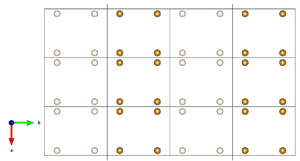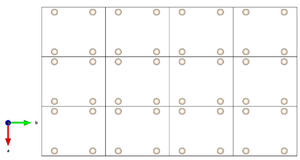Superstructure
From Online Dictionary of Crystallography
Surstructure (Fr). Superstruttura (It). 超構造 (Ja).
A superstructure is a crystal structure S’ obtained from another crystal structure (called a basic structure) S under the following conditions:
- the space group G’ of S is a subgroup of the space group G of S;
- the translation subgroup T(G’) of S’ is a subgroup of translation subgroup T(G) of S, i.e. the unit cell of S’ is a supercell of the unit cell of S and the lattice of S’ is sublattice of the lattice of S;
- the point group of P’ of S’ may either coincide with the point group P of S or be a subgroup of it;
- at least one of the Wyckoff positions of S is split into two or more independent Wyckoff positions of S’ and the corresponding crystallographic orbits are occupied by chemically different atoms.

A structure S' obtained from S by reducing its translational symmetry. Atomic positions represented by a different colour are not equivalent in S' and are occupied by chemically different atoms. S is called a basic structure, S' a superstructure of S. Vertical lines expanding beyond the horizontal boundaries of the unit cell indicate the translations along the b direction that are lost in the superstructure.
See also
- Derivative structure
- Substructure
- Buerger, Martin J. (1947). J. Chem. Phys. 15, 1-16.
